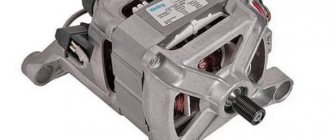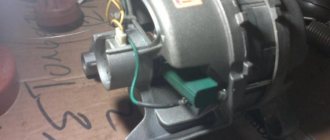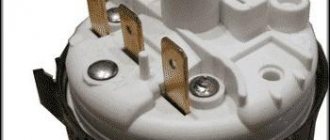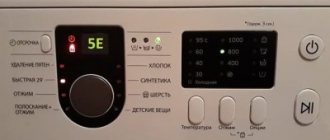Causes
If the machine does not drain water or spin things out, you should first find out the reason. In this situation, the reasons are divided into two types:
- Problem during operation:
- clogged drain hose, filter or pipe;
- incorrectly connected hose;
- Wrong choice of washing program.
- Breaking:
- breakdown of the pressure switch - the water level sensor in the machine, which is responsible for timely draining;
- failure of the electronic drain system;
- electric pump failure.
Problems with the programmer
Failures in the operation of equipment do not always lie in mechanics or electronics. Sometimes they are caused by the human factor. Some Indesit machines have programs that have wash and drain modes. Delicate laundry is supposed to be wrung out manually. If there is a pause, you need to check the set parameters, and in case of an error, turn off the equipment and carry out the settings again.
If the washing machine does not drain water when started correctly, the reason may lie in the programmer. The electronic control module of the equipment consists of chips and microcircuits. Only a person with experience and education can understand its structure. But, having the skills to work with a soldering iron and a multimeter, you can find and replace the burnt part. If you are not sure, then it is advisable to call a specialist and not risk an expensive module.
Another sign of electronic failure is the display of the corresponding error code on the display. To decipher it, you need to compare the readings of the device with the operating instructions.
Damage to the water level sensor
If repairing or replacing the module does not help solve the problem, then it may be a breakdown of the water level control sensor (pressostat). When the washing machine does not drain, this sensor either does not work or gives incorrect readings. You should not immediately contact a service center, as you can carry out repairs yourself.
To do this you need to do the following:
- Disconnect the device from the network.
- Remove the top cover.
- Unscrew the pressure switch. It is a small round plastic part that is attached to the top of the case.
- Blow into the plastic tube extending from the part. If there are no clicks, then the sensor is faulty.
- Take measurements with a multimeter. The readings on the meter should change as the pressure changes.
- Clean the tube.
- Refresh the contacts and tighten them tightly.
- Reinstall the sensor. Perform a test run.
If, after the measures taken, the SMA Indesit does not drain the water, then the pressure switch should be replaced. This is not difficult to do even for a person inexperienced in such matters. You need to buy a model corresponding to the broken part, attach wires and a tube to it, insert it into the socket and screw it to the body.
Troubleshooting Yourself
Initially, you should check whether the washing mode is selected correctly. Every Beko washing machine has a cycle that washes delicate fabrics and woollens without spinning. If it is installed, then after washing, you must separately start the process of draining the water. To do this, press the “Start” or “Start” key.
You also need to check whether the drain hose is connected to the machine correctly and assess its condition. If it is too bent or pinched, the water will not drain. In addition, the hose may be clogged with debris. In this case, you should clean it. The length of the drain hose plays an important role when draining water. If a hose longer than 1.5 m is installed, the pump will not be able to pump water over a long distance.
Also, the machine may not drain water due to a clogged filter. In Beko washing machines, the filter is located behind a small protective panel on the right side. You need to remove the filter by turning the holder to the right. Prepare a basin in advance, because water also accumulates in the filter compartment. Afterwards, the garbage disposal must be cleaned and rinsed under the tap.
When using the machine for a long time, the drain pipe also needs to be cleaned. You can get to it from the bottom of the machine, armed with a screwdriver. The pipe is held on by three fasteners that need to be loosened. Having separated the part, we clean it with a small brush, and then install it back. If you find cracks or holes in the drain pipe, it must be replaced with a new one.
To prevent washing machine maintenance, you can also clean the filter installed on the water supply. You can find it on the back panel of the machine, where the hose is attached. Cleaning it prevents the accumulation of sand and rust from tap water.
There is also a drain pump on the back of the washing machine. If the machine hums strangely when washing and refuses to drain the water, then you should pay attention to it. Beko washing machines are equipped with a self-diagnosis function and often detect a breakdown of the pump in the pump responsible for draining the water. And the lit H5 key on the control panel notifies you of this. However, in case of minor failures, the controller does not respond. For example, the impeller in a pump may become loose and fall off, which can be detected by a humming sound.
More serious problems that require replacement parts
Let's look at other reasons why the Indesit washing machine takes in water but does not wash. Here it is advisable to involve men’s hands, because you will have to disassemble the car body, ring parts, etc.
Drum belt (except direct drive machines)
It could simply fly off during an intense spin cycle, when the laundry got wrapped up in a ball and shook the drum violently. Unscrew the machine body and inspect the fallen belt. Top-loading machines will have the belt on the side, while front-loading machines will have the belt on the back. If there are no frayed areas or small tears, then simply put it back on.
If the belt is torn or greatly stretched, it must be replaced with a new one. It can be ordered in a specialized online store. Look at the markings on the old belt, measure the diameter and width. Place the new belt on the motor pulley, and then on one side of the large drum pulley. To put the belt on completely, you need to turn the drum counterclockwise.
TEN (tubular electric heater)
The machine, having filled the water, should heat it up to the programmed temperature. If the heating element fails, the wash will not start, and the sensor that starts the motor will not work. In order to inspect the heating element, you need to remove the front or rear panel (depending on the machine model, see the location of the heating element in the instruction diagram). To disconnect the part, you need to disconnect the wires and unscrew the nut in the center. After removing the heater from the tank, remove scale and inspect its surface. Blackened areas clearly indicate that the part is unusable. To do everything correctly, by
How to drain the water yourself
What should I do if pressing the buttons fails to drain the water? You can also do this manually. There are several ways to empty the drum of water:
- Water can be drained through the hole after removing the drain filter of the machine. To do this, unscrew the filter cover and tilt the machine. Substituting the container, you need to drain all the water and then take out the laundry.
- If water does not flow through the filter, then the problem is a blockage. It will need to be cleaned.
- Beko washing machines come with an additional drain hose. So, if the first options do not work, you can run the hose into the drum and drain the water.
Drain hose
A clogged hose is a fairly common situation. And there are treacherous circumstances. For example, a coin gets stuck. This is difficult to determine.
To clean, perform the following steps:
- put the car on its side;
- cover the motor with a plastic bag;
- disconnect the drain hose from the pump, after first removing the metal clamp with pliers;
- get out of the car;
- rinse under running water;
- install back.
Advice. The hose is corrugated, so squeezing and unclenching will help clean it.
Troubleshooting
If the water from the washing machine does not drain, then the reasons, in addition to clogging, may be serious damage. At this stage, it is better to contact professional technicians for high-quality diagnostics and further repairs. There are three main reasons why a washing machine does not drain water:
- Malfunction in the drain pump . It can be installed on the impeller. As stated above, it will either not move or may even break if overloaded. In this case, the technician will replace the pump with a new one.
- The problem may also be hidden in the control module . If the control module fails, the signal is not sent from the board and the pump does not begin to drain water. The technician needs to disassemble the machine and fix problems with the programmer.
- If the drum is frequently overloaded, the water level sensor may fail . The sensor must be replaced, because if it breaks down, it does not detect the water level and sends a signal to the control board to indicate the end of the wash.
Related article: Connecting a washing machine yourself
There are many reasons for the water not draining from a washing machine, and each of them has its own nuances. It is not always possible to install them yourself, much less repair them. Therefore, it is advisable to contact a specialist. Of course, using the above steps, you can clean the filter and hoses of the machine yourself. If the procedure does not fix the problem, then it’s time to entrust it to a professional.
Common problems
If the Atlant washing machine does not drain water and does not spin, you can suspect the following breakdowns:
- Blockage . Before the pump, which is responsible for draining water from the tank, there is a small filter of the Atlant washing machine. You can find a whole bunch of garbage here. If it is heavily clogged, it becomes impossible to pass and drain water. Sometimes all it takes is one coin to cause a problem. It is necessary to carry out cleaning activities by unscrewing the filter and washing it thoroughly. However, if the pipe is clogged, you will need to call a technician and open the washing machine body to restore the drain function.
- Pump fault. This unit is compact in size, but plays a very important role. The water flow is generated by the rapid rotation of the pump. If it is burnt out, it will need to be replaced in order to resume draining water.
- Failure in the control module or programmer of the Atlant washing machine. There may be damage due to the operation of the control module. As a result, the signal from the board cannot be sent to the pump motor, so the water is not sent to the drain. The solution is to repair the control module.
- Failure of the sensor , which is designed to monitor the water level in the drum - it does not indicate whether there is liquid in the machine. A signal is sent to the control module that the water has been drained.
Such drain breakdowns are considered the most common.
We are looking for the reason ourselves
- Check if the mode is selected correctly? Almost all machines have a washing mode with a stop with water, that is, without spinning. Typically, this mode is used for delicate fabrics or wool: gentle rinsing without spinning does not deform things - they do not stretch or wrinkle. If the water stop mode is selected, you must press the “Start/Pause/Cancel” button and start the water drain program.
- Check if the drain hose is ok? It may be “kinked” or compressed so that water cannot physically pass through the bend.
- Check if there is a blockage in the drain or siphon (if the drain hose is connected to the siphon)? To do this, you need to disconnect the hose and hang it in the bathroom or sink, and then turn on any mode. If water flows freely from the hose, it means there is a blockage in the sewer system. It needs to be cleaned, either yourself or by calling a plumber.
If you made the right choice of program and all “external communications” are normal, then we are talking about a breakdown in the machine itself. In this case, we recommend turning off the washing machine from the network, removing the laundry from the tank and draining the water using the drain filter (it is located in a small hatch at the bottom of the unit).
Do not forget to place a basin or bucket so that the water from the machine does not spill on the floor!
Reasons why the washing machine does not drain water
The drain mechanism of the machine is extremely simple. A pump and a drain hose connected to the sewer are responsible for draining the water.
When starting, the machine draws water. After the wash is completed, water from the drum passes through a corrugated tube with a filter, then enters a pump, which, under pressure, pushes the liquid into the drain hose.
If the washing machine does not drain water, the reasons may be as follows:
- hose clogged;
- incorrect choice of washing program;
- breakdown of the pump or other part.
Most of the faults that cause the drain to not work depend on the service life of the machine and the operating characteristics.
Blockage
A common reason for a washing machine not draining is a clog.
Clogging occurs when pins, nails and coins from clothing pockets get into the washing drum. Fallen objects are washed out along with waste water.
Modern machines have a protective strainer installed at the drum outlet. Debris does not pass through the fine mesh of the mesh, so it gets stuck in the filter.
Small fibers of fabric, threads, hair, and animal fur from clothing can even pass through the filter mesh. In this case, the clog clogs the drain hose, so the washer cannot drain the water.
The machine can become clogged and stop draining liquid due to time of use or the carelessness of the owner.
Wrong program selection
The machine will not drain water if the non-draining washing mode is selected.
Spinning and delicate washing, for example, do not use the drain mechanism. To drain the water, you need to install this program manually.
In most washing machine models, the pump will not pump out water in hand wash mode.
To select the correct washing program, the housewife should study the instructions describing the features of each mode.
Damage to the pump or other parts
Long service life, blockages and hard water can damage the drain pump. A faulty pump will hum constantly or stop turning on.
Damage to the electric pump can be caused by running without water. This usually happens when the impeller jams. The part with the blades is located inside the pump. The impeller rotates, converting energy from the motor into pressure to mix the liquid. Stuck threads or hair block the impeller blades, and it stops turning water in the washer. As a result, the pump runs dry and burns out.
The electronic control board may break. The cause of its malfunction is usually a short circuit. A power surge causes capacitors and microcircuit wire contacts to burn out.
Why the washing machine does not drain: the most common breakdowns
Below we will describe the main types of faults that can lead to the washing machine not draining water. At this stage, we recommend contacting a service center and calling a washing machine repairman for an accurate diagnosis.
Clogged water drain filter or pipe
There is a blockage in the system. As a rule, a filter is located in front of the drain pump. It traps threads, lint and small objects that, if they get into the drain pump, can damage it. Perhaps this filter is so clogged that it does not allow water to pass through. It needs to be cleaned. To do this, unscrew the filter and rinse under running water. If a blockage occurs in the pipe, then it is necessary to open the body of the machine. In this case, you most likely cannot do without a specialist.
Pump fault
The pump (pump) “burned out”. The pump in the washing machine looks like a small carousel. Rotating at high speed, it expels water into the sewer hole.
If the pump burns out, it needs to be replaced.
The control module (in electronic washing machines) or the programmer (in models with electromechanical control)
Related article: How to eliminate odor in a washing machine
If the control module fails , the signal from the board does not go to the pump motor and the water does not drain.
The control module needs repair.
Water level sensor is faulty
If the pressure switch (water sensor) breaks down, it does not detect that there is still water left in the machine. The control module receives a signal that all water has been drained and the program can be completed.
Sensor replacement required
* The table shows the approximate cost. The technician will provide an accurate estimate for repairs after inspecting the washing machine, taking into account the nature of the breakdown, as well as the manufacturer and model.
** Prices are indicated only for the work of the master, without taking into account the cost of spare parts.
As you can see, the reasons why the washing machine drain does not work are quite varied. If we are not talking about a simple blockage, then it is virtually impossible to determine on your own what happened: this requires special diagnostic equipment, knowledge and experience. So, if your washing machine is malfunctioning, feel free to contact RemBytTech:
+7 (495) 215 – 14 – 41
+7 (903) 722 – 17 – 03
Our washing machine repair specialists know the weak points of appliances of any brand and will determine the exact cause of the problem right at your home. In addition, we carry out diagnostics completely free of charge!
If you agree, the technician will fix the breakdown in a matter of hours, and your life will return to normal: no hand washing clothes or other unpleasant activities!
Possible reasons for water not leaving the washing machine
Why is it impossible to drain the water from the washing machine? The reasons for such a breakdown can be of different nature. Among the most common reasons are:
- There is a blockage inside the siphon or in the drain pipe. Water cannot pass through the accumulated debris, so it remains inside the drum;
- The drainage hose was too bent;
- Selecting a washing machine operating program that does not allow water to drain. This situation often arises when choosing a program for washing woolen items;
- The presence of serious clogging of the drain filter, which most often occurs when coins, paper clips, pins, buttons and other small objects get into it;
- The drain pump is faulty or severely clogged;
- Clogged pipe that connects the washing machine drum to the drain pump;
- Failure of the control module that programs the operation of the washing machine (a common problem with BEKO machines);
- Failure of the water level sensor inside the washing machine tank. In such a situation, the sensor can determine the water level is less than it actually is, for this reason a certain part of the water will remain inside the drum.
In some situations, a similar problem occurs when the washing machine drum is overloaded.
Many modern washing machines can indicate the presence of such an error by issuing a graphic signal on its display.
Error code in various washing machines:
- Indesit and Ariston signal an error by displaying the combination F05 or F11 on the screen;
- Bosch and Siemens will show F18, D02 or D03 on the display;
- Electrolux and Zanussi will issue the code EF1;
- Samsung will notify you via code E2;
- Beko will issue the code H5;
- Whirlpool will show F03.
Typical malfunctions of Beko washing machines
By entrusting the inspection of your car to an experienced technician, you can rest assured that he will quickly and professionally find what the problem is. But due to the high prices for services, many home craftsmen are trying to save money and repair the Beko washing machine themselves.
Almost any SMA model can be repaired at home: ELB 57001 M, RKB 58801 MA, LNU 68801, etc.
This approach is quite justified - often repairs are exorbitantly expensive, and sometimes the price is such that you can buy a new machine. At the same time, even the most “killed” car can last for several more years after repair.
Don't want to throw away your Veko machine and buy a new one? Try to figure out the problem yourself and fix everything yourself.
The design of the Beko washing machine also determines the nature of its breakdowns. Let's look at typical malfunctions of washing machines of this brand:
- The water does not heat up to the set temperatures; washing is done in cold water on any program. Or vice versa - the water overheats.
- Water slowly fills into the tank or does not fill at all.
- The Beko washing machine does not start because the hatch does not close tightly enough.
- There is water standing in the tank at the end of the wash (this may be accompanied by a strong hum).
- The rotation of the drum occurs with grinding, roaring, clanging and other uncharacteristic sounds.
- Not a single washing mode starts - all the lights on the machine blink. Or the program works, the indicator lights up, but the machine does not wash.
- It is not possible to start the machine with the power button (with the power cord plugged in).
- Models with an electronic display display error codes H1, H2, H3, H4, H5, H6 and H7. The machine doesn't work.
Important! There may be other signs of failure. We looked at the most common ones among Beko SM users in Russia.
Features of typical breakdowns of Beko washing machines
As mentioned earlier, all malfunctions are accompanied by certain symptoms - from minor malfunctions to complete failure. The problem of the home handyman always lies in one thing - how to connect the existing signs of breakdown with its causes. Here you just need the knowledge and advice of specialists of a narrow profile.
Related article: How to get rid of washing machine smell
Next, we will briefly summarize information about the main breakdowns.
Problematic drainage of waste water in Beko machines
If you know how to use a Beko washing machine, then you know that the waste water after washing is not clear and clean - this is the specificity of washing. To prevent dirt, threads, hair, etc. from clogging the pump, there is a special drain filter on the way to it, which mainly suffers from blockages.
Your task is to find this filter, which is usually located at the bottom of the washing machine, under a small hatch or behind a panel. How to proceed next:
- Before removing the filter, do not forget to place a basin or a rag under the machine, because residual waste water will definitely flow out of the hole.
In a number of Beko models, along with the filter, an emergency drain hose is also included - with its help it is much more convenient to drain water into any container.
- To remove the filter, simply twist it to the right.
- Next, clean the filter by hand and rinse under the tap.
- Armed with a screwdriver, you can also clean the pipe - it usually also becomes clogged with debris from waste water.
- Once you have the tools at hand, do not rush to put them away - for preventive maintenance, also clean the filter that is located on the water supply (it is located at the place where the hose is attached to the rear panel). Sand and rust from the water supply slowly collect in this filter and eventually interfere with the normal flow of water into the drum.
- After cleaning the inlet filter, do not rush to put it back in place - also check the drain pump. Often, Beko washing machines, during self-diagnosis, detect a breakdown of the pump and signal this using fault code H5. But in case of some breakdowns, the controller may not see minor violations - such as a loose impeller (can be identified by hearing a hum).
- To check the pump, start the drain mode and look into the hole in the filter plug to see how the impeller behaves. If it rotates, then everything is in order, but if not, then the pump needs to be cleaned or even replaced.
Problem with water heating in Beko machine
To fix this problem, you will also need to at least partially disassemble the Beko washing machine, but more on that below.
First, let's say that in the SM one of the most vulnerable components is the thermoelectric heater, simply the heating element. The mineral salts present in the water crystallize under the influence of hot water and settle on the heater in the form of the familiar scale - like in a kettle. The coating does not allow heat to pass through, so the heating element does not transfer it to the water and burns out.
If there is no scale, you have soft water, or you use special products, this does not mean that the heater could not burn out. The heating element has its own production resource, and maybe its time has come.
If the heating element fails, you will know about it by errors H2 and H3. To be absolutely sure what happened to it, first get to the heater. In some Beko models it is located at the rear, in others it is at the front.
So, how to disassemble a Beko washing machine, find the heating element, check and replace it, read on:
- If the heating element is located at the front, then to remove the front panel, you need to remove the hatch cuff. To remove it, act carefully - if something goes wrong, then your activity is fraught with damage to the cuff and leaks.
- You will not see the entire heating element - only its shank with two contacts and wires going to them.
- Disconnect all wires.
- Take a tester and measure the resistance. Typically, normal readings will be 25-30 ohms. If the indicators are different (for example, infinity), then the breakdown is obvious.
- Remove the heating element by unscrewing the nut from the bolt that holds it under the drum.
- Clean the installation site from debris and deposits.
- Install the new heating element in the reverse order, reconnecting all wiring.
This video shows in strict sequence how to remove, check and replace the heating element:
Example of a pipe clogged with debris
- If the washing machine does not drain water and is humming, then responsible for pumping water failed It consists of an electric motor, a shaft with a plastic impeller and two pipes. The service life of the pump is about 5 years. Often, technicians disassembling the pump find threads and hair wound around the impeller shaft, which were the reasons for the failure. In addition to the engine burning out, the impeller may also break, but the entire assembly changes, in this case, entirely.
- Electronic control module malfunction . Its failure may occur due to power surges or due to natural wear and tear of electronic elements.
- Drain hose is too long. Over time, the power of the drain pump gradually decreases. Usually this power is enough to drain water through a standard hose about 1.5 m long. If a longer hose is used, then the pump may not be physically capable of pumping water over such a distance. Typically, such a failure occurs if the old machine is moved to another place, lengthening the drain hose twice or more.
Drain hose of an automatic washing machine in a siphonMany modern machines have digital displays that display not only operating modes, but also error codes that occur. Using these codes, using a special table in the instructions, you can determine the nature of the malfunction for more accurate diagnosis.
Some programs installed in washing machines may not provide a spin mode, so the machine waits for an additional command, pausing during the washing process. Therefore, if the washing machine does not drain the water and does not spin, then you need to make sure that the machine is set to the required operating mode.
Important: If the washing machine fills with water and immediately drains it, the reasons may be a failed water level switch, a malfunctioning inlet valve, or a problem with the electronic module. In the latter case, you are unlikely to be able to fix the problem yourself.
Dismantling the pump
Often the pump is to blame for difficult drainage. It is she who must pump out dirty water from the tank, so when it stops, the washing machine cannot empty the drum. To correct the situation, it is necessary to diagnose and repair the pump. But first you have to get it out of the machine.
On Beko washing machines you can get to the pump through the bottom. You need to prepare a wrench, screwdrivers and a container for collecting water, then disconnect the machine from the communications and begin disassembling. We proceed according to the following scheme.
- Use a flat-head screwdriver to pry up the technical hatch and unclip it.
- Unscrew the garbage filter.
- We release the pump from the retaining bolt.
- We unhook all connected wires and pipes.
- Turn the pump counterclockwise while pushing the pump deeper.
- We put our hand through the bottom and pull out the pump.
- Place the part on a dry surface and begin troubleshooting.
Before disassembling, the washing machine must be disconnected from communications!
To make it more convenient to get to the pump with your own hands, you can put Beko on your left side. In this case, you will not have to act by touch, which will speed up the dismantling of the pump. We take out the disconnected pump and begin diagnostics.
How to drain the water from the washing machine yourself?
If the automation refuses to drain the water, you will have to perform this procedure yourself. Let's look at how to drain water from a washing machine. There are several ways to do this. Choose the one that is most convenient for you and drain all the liquid from the tank:
If water does not flow through the filter, clean the pipe through which you drain the liquid. Sometimes it is enough to move the pipe slightly for water to flow out of it.
Symptoms of the problem
Constant or periodic problems with drainage during the washing machine operation cycle indicate a malfunction. Using broken household appliances is not only undesirable – it’s dangerous. The symptoms of a technical problem are as follows.
- Wash takes too long - beyond the specified programme.
- The water does not drain at all, or the machine stops on the drain program after washing.
- Intermittent problems. Several washes go well, and then a failure occurs.
- The display notifies you when the washing and spin cycle is complete, and the laundry is wet or the bottom of the drum is filled with water. When washing without spinning, there may be too much water to open the machine.
- The washing phase takes place precisely in time, but during rinsing the machine freezes, it can rinse for a very long time, the drum sits idle for a long time.
- The spin function does not work.
Problems can arise in isolated cases, be combined, or be present constantly - all this indicates a breakdown of the unit.
Troubleshooting steps
We list the procedure for troubleshooting:
1. Disconnect the washing machine from the power supply.
2. Cleaning the filter. On the front side of the machine, at the bottom, there is a hatch under which the filter is hidden. It needs to be unscrewed and inspected. If it is clogged, it must be washed with water. If the cause of the problem was the filter, then when you unscrew it, water will flow from the pipe. To prevent flooding, you need to prepare a basin for water.
Cleaning the washing machine filter
3. If the washing machine still does not drain the water, what should I do? Checking the drain pipe. To disassemble it, you need to unscrew the fixing screws of the drain assembly. After this, the pipe is removed and checked. If it gets clogged in some place, you can feel the blockage with your fingers. After checking, the pipe is installed in its original place.
Drain pipe
4. Also, one of the reasons that the washing machine does not drain water may be that the impeller is jammed. It is located behind the filter. Often some small objects, as well as threads, get into it. Check if it rotates freely. To do this, scroll through it. If the impeller does not rotate, it means that it is jammed and will have to be freed from objects interfering with it. If it is not jammed, then the pump itself is likely to fail.
5. To diagnose the pump, you need to unscrew the filter and set the spin program in the washing mode selection menu. Use a flashlight to illuminate the drain hole. If the pump impeller is in a stationary position, then a breakdown of the pump should be suspected. A faulty pump needs to be replaced.
6. There are times when the pump impeller rotates during a dry spin, but the water does not drain. This type of malfunction is more typical for older units, the components of which are already quite worn out. Inside the pump, in a plastic cup, there are permanent magnets. The glass is protected from water getting on the magnets by a cuff located on the shaft. When voltage is applied to the pump winding, the permanent magnets begin to rotate, causing the rod to move.
If the sealing collar is damaged, then water begins to seep into the glass, and with it dirt. As a result, the magnets cannot work fully, and the pump jams in spin mode. In addition, over time, the magnets themselves can gradually demagnetize, which also leads to a decrease in pump power. A sign of such a malfunction is the noise emitted by the pump. In this case, the pump itself does not work, but only makes noise.
Tip: If your machine is more than 6-7 years old and it makes noise in the spin mode, the probability of the pump failure is very high. It needs to be replaced.
What to do if the water in the washing machine does not drain completely?
We eliminate defects
- First of all, check what program is set for washing. Apparently a function that does not drain water was used
- If the problem is not related to the program:
- Drain the water in one of the following ways:
- Unplug the cord from the machine from the outlet
- Remove the cover from the drain filter
- Without pulling out the filter base, pull out the small tube (if available)
- Direct the end into a pre-prepared container
- Or lower the drain hose to floor level
- Check to see if the drain hose is kinked somewhere.
- We clean it by separating it from the unit using a powerful water jet. The reason may be that the hose is clogged
- Inspect the garbage filter for debris and remove debris if necessary.
- Wash the filter in soapy water. If this is not done periodically, a dirty filter may cause the problem in question.
- Inspect the pipe connecting the tank to the pump. Maybe it needs to be cleaned
- Remove and clean the pump
- If, after eliminating minor causes, the machine does not start working normally, then more serious breakdowns listed above have occurred. In this case, it is better to call a specialist.
Video: Why doesn't the washing machine drain? Secrets of a Household Appliance Seller
What to do if the washing machine does not drain or spin?
Let's try to fix it ourselves
If you can't use the services of a trusted specialist, you can try to fix the problem yourself.
- Disconnect the washing machine from the water supply, sewerage and electricity
- Line the center of the spare room with rags
- Move the unit there
- Put it down on the floor sideways
- We check and repair the pump
After removing the blockages, the machine continues to give the same error, you need to check the functionality:
- Removing the drain pump
- We check the resistance with a multimeter, if zero or one is displayed on the display, it means the pump has burned out, you need to buy a new one and replace it
- In normal operating mode, the electrician looks for a problem in the operation of the mechanism completely
- Checking the tightness of the impeller on the axis
- We inspect whether there are any unnecessary wound objects (hair, threads) on the base of the impeller
- At the same time, we check whether the wires and terminals connecting the pump with the drain pump have burned out or jumped out
- If there are no problems with the pump, move on to checking the next part
- We test the operation of the pressure switch
- Removing the top cover from the washing machine
- We take out the water level sensor
- We check for external damage or blockages. Clean if necessary
- We check the functionality of the device itself as follows:
- We pull a small hose onto the fitting, blow into it, bring it to the ear: if a clicking sound is heard, then the part is working, if not, you will have to change it
- Testing the control module
- It’s difficult to handle electronics on your own. Therefore, at this stage it is better to contact a specialist
- The only thing you can do yourself is to feel and inspect all the wires going to this part, check them with a multimeter
If the washing unit Samsung, LG, Indezit, Bosch, Kandy, Atlant, Zanussi, Ardo, Ariston does not want to drain the water and spin the laundry, look for the problem of its “behavior” without delay. Over time, a minor problem can turn into a serious and expensive repair or complete replacement of the device.
Video: The washing machine does not drain or spin. Elimination algorithm
heaclub.ru
The washing machine does not drain water, what should I do?
If you are reading these lines now, it means that something has happened to your washing machine and most likely it is not spinning or draining water. Now, almost all users know that direct spinning depends on draining the water, so we will consider the cause, not the effect. Below we will look at the most common faults associated with this breakdown. To begin with, I want to say that a clogged filter is not always the cause. Oddly enough, the plug that you unscrew from the pump body very often does not become an obstacle to paper clips, matches, small coins, etc., which get under the pump impeller and into the drain hose; as a result, these small parasites interfere with the proper operation of your SMA. In my practice, it often happens that threads are wound around the impeller and, as a result, they do not allow this mechanism to rotate. Below I have posted a video in which, using a Gorenje washing machine as an example, you can see how to clean the drain pipes and hoses. Now let’s move on to all the reasons that may cause water to not drain from a washing machine.
Why is there no water draining from the washing machine?
- The drain pump filter is clogged. First of all, you need to unscrew the plug, which is also the filter for the pump, rinse it well, and most importantly, thoroughly wash the place on the pump body where the rubber of the plug and the body come into contact, this is necessary in order to avoid water leakage. After you have unscrewed the plug and the water has completely drained, take a flashlight and shine it inside, with your finger or some other object, you can use tweezers, rustle under the impeller, very often coins, matches and other small objects will get stuck under it. After you have completed this entire operation, you can tighten the plug and check how your machine will drain
- The drain pump is faulty. Here it is important to know that the pump is supplied with a voltage of 220 volts, that is, to check it, you can do the following, take some wire with a plug and apply 220V to the pump; if the pump works, this does not mean that it is working . To be completely sure, you need to turn it on and off 5-10 times, because sometimes during the startup process the pump stops. Be sure to check the play on the impeller; if it is large, the pump needs to be changed. It is advisable to carry out this entire procedure with the drain pump removed.
- The water drain hoses are clogged. Very often, I take out various foreign objects from the main pipe, which goes from the tank to the pump body. It’s easy to check if the hoses are clogged, you need to fill the tank with as much water as possible and lower the drain hose into the basin, if the water flows well by gravity, then the hoses are clean
- The pressure switch (water level sensor in the tank) is faulty. The pressure switch or water level sensor fails quite rarely, but it does happen. First, you need to blow out the tube that fits the pressure switch; it is the one that is largely responsible for drawing in and draining water. It often happens that it becomes clogged with dirt and as a result, something like a valve is formed in it
- The control unit has failed. In this case, you can’t do without calling a technician, the only thing I can say is that in different control modules, a triac and a relay are responsible for turning on the pump, but if you don’t understand much about electronics, then it’s better not to get involved in repairing this spare part
Now I suggest you watch a video about why water remains in the washing machine
Here you can also add that, as I already wrote above, the pump is supplied with a voltage of 220 volts and in order not to mess with the wires, you can simply drain the water from the washing machine and set the washing mode to “Drain”. In this mode, the machine will not draw water, but it turns on the drain pump, thanks to this you can personally observe the operation of the pump. The disadvantage of this method is that you cannot turn the power on and off several times in a row. I also forgot to mention one thing: to blow out the drain hose, you must unscrew the filter plug, this is done so as not to blow the ball out of the main pipe. Good luck with the repair, if you do everything as I wrote, you will probably save a considerable amount of money
sammaster.xyz
How to change the pump yourself
One of the most difficult failures, in which the washing machine has stopped spinning and draining water, and is also humming, is a pump malfunction. In this case, it will most likely need to be replaced.
Washing machine pump
Let's look at the procedure for replacing the pump:
- The drain assembly must be removed.
- The drain pump is detached from the drain assembly.
- The wires that go to it are removed from the pump.
- A new unit is installed in place of the old pump.
- Wires are connected to the new pump.
- The drainage unit is installed in its place.
- The machine is connected to the network and a test wash is performed.
- If the washing machine continues to drain water poorly, contact customer service.
Causes and symptoms of malfunction
How the user can understand that a malfunction has occurred:
- Pay attention to the first signs of breakdown. For example, water drains more slowly than usual.
- The automatic washing machine does not drain water at all.
- The wash cycle proceeds as usual, but when it reaches the drain, the system freezes.
- The machine drains the water after one wash.
- After draining, spinning does not start.
- After the main wash the water is drained, but after rinsing it is not.
You may also notice a strong noise: the machine will hum, as if draining waste water.
Why did the breakdown occur:
- The wrong mode is set.
- The drain pipe, hose, and sewer are clogged.
- The pressure sensor has failed.
- The drain pump is broken.
- The electronic board has burned out.
Rules for the operation and prevention of the washing machine
To ensure that your washing machine serves trouble-free for many years, we advise you to follow some simple recommendations:
- Each washing machine model is designed for a certain weight of laundry loaded into it. If this weight is exceeded, the unit will wear out. In this case, the likelihood of failure increases many times over.
- There is always some kind of garbage in the pockets of the laundry loaded into the tank. These could be pins, paper clips, coins, headphones, pieces of paper, etc. Any of them can damage the pump, impeller, or motor. Remember to inspect all clothing before loading.
- It is better to connect the machine to the power supply not directly, but through a special surge protector. It smoothes out voltage surges, which are not uncommon in our networks. Small jumps are not harmful to the washing machine, since this is provided for by its design, but large differences can lead to damage to the electronic unit.
- Do not forget to regularly clean the filter located under the hatch on the front wall. This should be done annually, or even better - every 6 months. If the filter is clogged, this may be one of the reasons why the washing machine does not drain water.
- Before starting washing, carefully set the required mode.
- Carry out preventive cleaning of the machine every year without laundry. To do this, you need to load the powder and descaling agent, set the highest temperature and carry out a full wash cycle. As a result, scale and dirt will be removed.
By using these simple tips, you will be able to use your washing machine for its intended purpose for many years.











